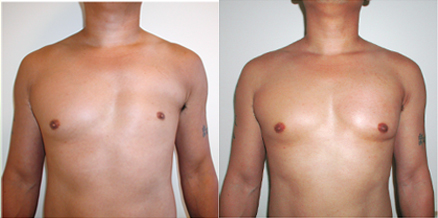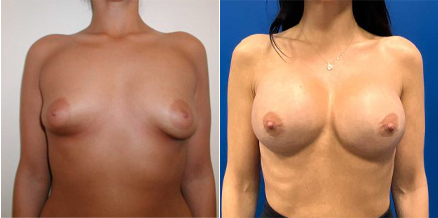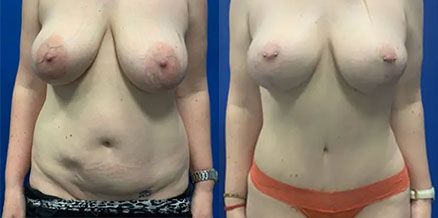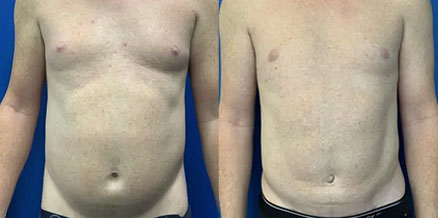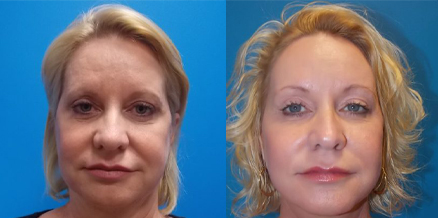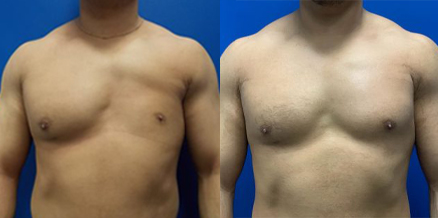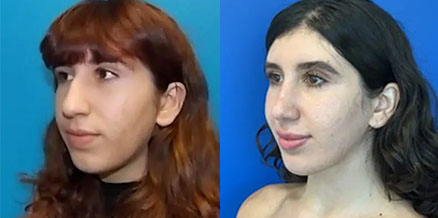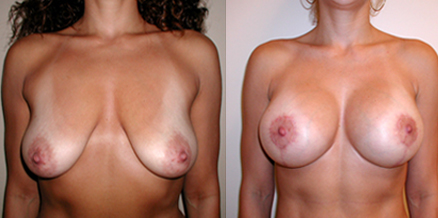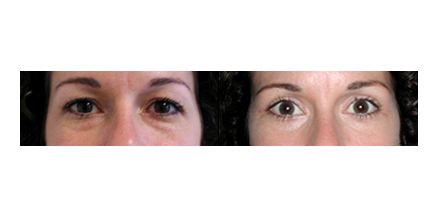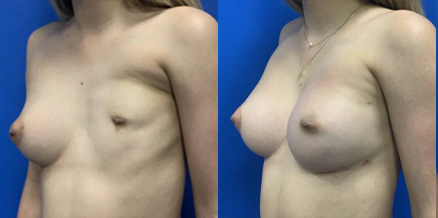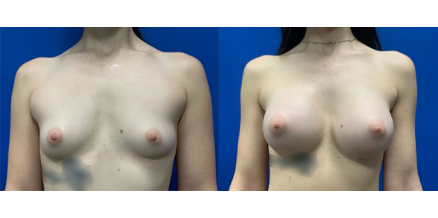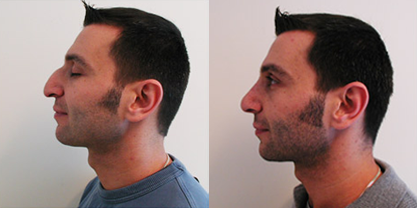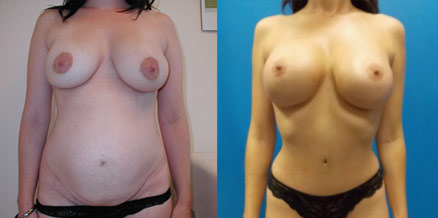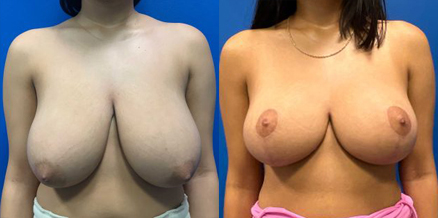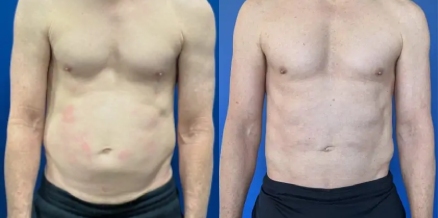After Weight Loss Body Contouring
Conveniently located to serve the areas of Beverly Hills, West Hollywood and Los Angeles

After weight loss body contouring is any cosmetic procedure that tightens loose skin after significant weight loss. (1) When people lose a significant amount of weight–50 pounds or more–the skin that had previously been held taut by fat deposits can take on a deflated look. Following weight loss, the skin may begin to sag in areas like the midsection (abdomen), thighs, back, breasts, chest, arms, buttocks, face, and neck.
Massive weight loss can happen as a result of a rigorous diet and exercise regimen, glucagon-like peptide-1 (GLP-1) medications like Ozempic, or after bariatric surgery. Some people may even experience similar skin sagging after a pregnancy. As a result of taking weight loss medication, patients may be left with “Ozempic body”, “Ozempic face”, “Ozempic breast”, and “Ozempic butt”; terms coined to describe the sagging skin that may remain after a person worked so hard to achieve their goal weight. Unfortunately, regardless of the method of weight loss, patients are often unable to minimize this skin sagging by simply continuing to exercise and eat healthily. (2)
Surgery tailored to your specific needs can remove and tighten excess skin and help bring out your attractive body contours and figure.
To make your life more comfortable, and to enjoy the best version of yourself after weight loss, schedule a personal consultation with board-certified plastic surgeon Dr. Mossi Salibian, so that he can understand your specific goals and suggest the right body contouring procedure for your unique situation.
Call our Los Angeles office at (310) 550-0750 or fill out our contact form to request an appointment.
Contents
- 1 About Medical Weight Loss
- 2 Body Lift Surgeries After Massive Weight Loss
- 3 Liposuction & Fat Grafting
- 4 Candidates
- 5 Personal Consultation
- 6 Preparation
- 7 Procedure
- 8 Recovery & Results
- 9 Cost of After Weight Loss Body Contouring in Los Angeles
- 10 FAQ
- 10.1 How soon after body contouring will my results be visible?
- 10.2 How many body contouring procedures can be performed at once?
- 10.3 Is it okay to lose more weight after body contouring surgery?
- 10.4 Are the results from body contouring surgery permanent?
- 10.5 How much weight can I lose with body contouring surgery?
- 11 References
About Medical Weight Loss
Semaglutide is a type 2 diabetes medication also known under the brand names Ozempic and Wegovy. Tirzepatide is a similar GLP-1 medication, which is branded as Mounjaro or Zepbound. GLP-1 is a hormone that helps control the digestive processes and cravings in the body. By mimicking this hormone, these medications have significant effects on a patient’s weight, as they reduce appetite and slow the emptying of the stomach into the small intestine. Tirzepatide is a slightly enhanced version of semaglutide, as it mimics two different hormone receptors. Bariatric surgery such as the gastric sleeve or gastric bypass, leads to excess weight loss by decreasing a patient’s food intake by making the stomach smaller or bypassing it entirely. (3)
When weight loss happens this quickly and significantly, patients are frequently left with hanging skin that only surgery can sufficiently address. Dr. Salibian offers a variety of different body contouring procedures that will serve to tighten the skin of the body and restore your figure after weight loss. The areas of the body most commonly affected by weight loss-related excess skin are the breasts, midsection, arms, and thighs.
Body Lift Surgeries After Massive Weight Loss
Body lift surgery is a broad term that describes various procedures that aim to improve and rejuvenate specific areas. They help to tighten the skin and enhance the overall shape and contour by addressing sagging tissues and unwanted fullness, which can occur due to aging, weight fluctuations, or genetics. These procedures are particularly beneficial for patients who may be experiencing post-weight-loss skin sagging and may be combined as a full body lift or a variation of the mommy makeover.
Breast Lift
After weight loss, it is common for the breasts to lose volume and begin to sag. (4) With a breast lift (mastopexy), Dr. Salibian can restore the breasts’ position and remove the excess skin that is causing sagging. He can also reposition the nipple higher to a more youthful location on the breast. After this surgery, bras, bathing suits, and summer tops may fit better and the breasts will appear and feel more firm. (4) Similarly, by tightening the skin and removing excess skin folds, patients often experience less discomfort when engaging in physical activities. Many patients report increased confidence, an improved self-image following a breast lift, and personal satisfaction.
Breast lifts may be performed with or without breast implants.
Male chest contouring procedures are also performed for men who wish to address post-weight-loss skin excess in the chest region. Gynecomastia reduction surgery, male chest wall skin reduction, and nipple lift and repositioning are common procedures that are performed in men to address the sagging appearance of the chest post-weight loss.
Tummy Tuck
A tummy tuck, also known as an abdominoplasty, removes excess skin to give the midsection a flatter look. (5) Sometimes a pouch of loose skin can form in the midsection as a result of massive weight loss–this skin can hang over the pubic area of the lower body and create discomfort for the patient. Abdominal muscles can also loosen and separate after weight gain or pregnancy.
Muscle separation at the center of the abdomen, which can be both above and below the belly button is called diastasis recti. Repair of diastasis recti is an integral part of a tummy tuck after massive weight loss as patients may have a wide degree of muscle separation or diastasis recti due to a history of being overweight. Diastasis rectus repair will realign the rectus muscle back to its anatomic location and result in re-establishing its function.
A tummy tuck can effectively help resolve some symptoms of the Ozempic body problem, as well as create a coveted “hourglass” figure in women and a tight “washboard stomach” in men. In addition, liposuction can also be utilized should there be residual fat deposits along the flanks and waist if necessary to further define the body figure. Some variations of the tummy tuck surgery include:
- Standard Tummy Tuck: This is the most common type. It entails a longer incision made from hip bone to hip bone but placed low at the pubic region, and involves reshaping the entire abdominal area. Often, it includes liposuction to address persistent fat deposits and muscle tightening at the center, repairing diastasis recti at the center along the upper and lower abdomen.
- Mini Tummy Tuck: For patients who only have minor excess skin below the navel, a mini tummy tuck may suffice. The incision required is shorter in length, typically slightly longer than the incision length for a C-section.
- Extended Tummy Tuck: This version is designed for patients with excess skin centrally and around the flanks and back, offering more extensive surgical correction than the full or standard tummy tuck. It is referred to as a Fleur-de-Lis Abdominoplasty.
- Circumferential Tummy Tuck: Frequently sought by patients who have undergone massive weight loss, this procedure addresses skin around both the abdomen and the back by using a longer incision that encircles the lower torso for a full body lift.
Arm Lift
For patients who are left with hanging arm skin after weight loss, an arm lift, or brachioplasty, can help eliminate these so-called “bat wings”. Excess skin and fat in this area can create an unbalanced look, which can detract from one’s overall figure. By focusing on the upper arms, Dr. Salibian can remove the excess arm skin that may be bulging beneath long-sleeved shirts or causing discomfort. The arms will appear more toned as a result. (6) The incisions for this procedure are discreet, and patients often feel more confident while wearing sleeveless tops.
- Traditional Arm Lift: This technique involves an incision that runs from the armpit to just above the elbow. It is best for individuals with significant amounts of sagging skin.
- Extended Arm Lift: The extended arm lift incision incorporates the traditional arm lift incision and dips just below the armpit into the inframammary crease. This variation addresses loose arm skin and excess lateral chest wall skin.
- Mini Arm Lift: This option is reserved to address mild to moderate arm skin laxity. The length of the incision is limited and hidden in the underarm area.
- Liposuction: For some patients, rather than surgically removing excess skin, liposuction alone may be sufficient. This method targets unwanted fat deposits and depending on the natural elasticity of the arm skin, the skin retracts to an extent without the need for excisional arm lift procedures.
- Combination Techniques: Some patients may benefit from a combination of lifting and liposuction techniques tailored specifically to their body, skin type, and desired outcome.
Thigh Lift
A thigh lift can be helpful after massive weight loss, as the excess skin in this area can cause painful chafing. In this procedure, Dr. Salibian will remove the sagging skin from the inner thighs and contour the posterior thighs and hips as necessary. This procedure enhances the overall figure after a patient has lost a lot of weight. (6) There are various different surgical options to achieve the best thigh lift which depend mostly on the location and extent of the excess skin. These include:
- Standard Thigh Lift: This is the most common type, which involves making a crescent incision in the groin area and extending downward along the inner aspect of the thigh. The excess skin from the thighs is then removed, and the remaining skin is suspended higher and tightened, smoothing out the appearance of the thighs.
- Crescent Thigh Lift: This technique is utilized primarily for corrections of inner thigh excess skin and involves a shorter incision located along the inguinal groove where the thigh meets the pelvis.
- Extended Thigh Lift: As the name implies, this approach includes a longer incision that extends toward the backside of the hip along the lower buttock crease and downward toward the inner knee via the inner thigh. It is suitable for patients who require more extensive lifting along the front of the thighs, the inner and back of the thighs, and the hips.
Buttock Lift
A buttock lift achieves smoother and more aesthetically appealing buttocks and enhances overall body proportions. The placement and design of buttock lift incisions depend on the desired outcome and specific anatomy of each patient. There are several common incision types used:
- Upper Buttock Incision: An upper buttock incision is typically placed just at the upper buttock curvature as it meets the lower back. A generous amount of upper buttock loose skin is excised as a crescent and buttock fullness and curvature are reestablished as the incision is closed.
- Lower Buttock Incision: A lower buttock incision is used when there is excess skin along the posterior thigh and lower buttocks. The incision is placed along the natural lower buttock crease and achieves both a posterior thigh lift and buttock lift. Depending on the extent of the loose buttock skin, some patients would need both an upper and a lower buttock incision to achieve an optimal buttock lift.
- Circumferential Incision: This 360-degree incision encompasses the entire waist and extends from the upper buttock posteriorly, along the hips, and then to the front meeting the tummy tuck incision. This is essentially a body lift if done as a single surgical procedure. Depending on the indication and best candidacy for a patient, it can be staged with two separate operations where the tummy tuck is done first and followed by a buttock lift several months after.
By understanding the anatomy and physiology involved, Dr. Salibian can employ tailored surgical techniques to achieve specific aesthetic goals desired by patients.
Liposuction & Fat Grafting
Liposuction after massive weight loss is designed for individuals who have successfully lost a significant amount of weight but are left with localized pockets of fat. It can help improve body contour by removing remaining fat deposits and providing a more sculpted, toned appearance. It is important to note that while liposuction removes fat, it does not eliminate excess skin. Therefore, Dr. Salibian often combines liposuction with body contouring procedures like tummy tucks, thigh lifts, or arm lifts to achieve optimal results.
Fat Grafting
Fat grafting employs the body’s own adipose tissue for reshaping other areas of the body and can be performed at the same time as skin reduction surgery. It is particularly beneficial for patients undergoing a breast lift who do not want implants placed, but still want a better cleavage and moderate increase in breast volume. The process primarily involves two steps: first, fat harvesting, which entails extracting unwanted fat from a donor site like the abdomen, thighs, or flanks using liposuction techniques; and second, the injection of this harvested fat into targeted areas that require increased volume or improved contour, such as the breasts, buttocks, or cheeks and other areas on one’s face.
Candidates
For people who have lost 50 pounds or more and experience bothersome loose skin after weight loss, body contouring surgeries are an effective way to enhance the figure with tailored procedures. Additional qualities that make someone a good candidate include:
- Non-smoker
- Stable body weight and optimized nutritional
- Healthy lifestyle; good nutrition, exercise, and consistent activity regimen
- Realistic expectations about what the procedure(s) can accomplish
Personal Consultation

At your personal consultation, Dr. Salibian will meet with you privately to communicate important information about the after-weight-loss body contouring process. Together, you will discuss what areas of your body will be most effective to address with surgery. You will also discuss your medical history and your specific goals at that time. After a substantial planning period, you will be able to schedule your after-weight-loss body contouring procedure(s).
To schedule your personal consultation today, please call our Los Angeles office near Beverly Hills in West Hollywood at (310) 550-0750 or fill out our contact form.
Preparation
Dr. Salibian and his staff will make sure you are well-prepared for your procedure by walking you through all of the steps that will occur before, during, and after body contouring surgery. In addition to precise measurements of the skin he will remove, he will also review and document the results of a cardiac and respiratory evaluation. (4) All patients are required to obtain medical clearance from their primary care doctors, as well as results from blood tests in order to prepare for the surgery. (4) There are also a few things you can do on your own to prepare:
- Plan to take about two weeks off work so that you can adequately rest.
- Arrange for a trusted individual to drive you to and from the surgery center.
- Arrange for a trusted adult to stay with you during your initial recovery phase.
- Stock your home in advance with groceries or supplies you may need.
- Adjust your medications and supplements per Dr. Salibian’s advice.
- Arrangements can also be made to recover at a cosmetic recovery facility as needed.
Procedure
Dr. Salibian will tailor your body contouring procedure(s) to your specific needs and desires. However, most surgeries will follow a similar order of events. Body contouring of the torso is performed first. Sometimes a thigh lift, if it is not an extended thigh lift, can also be performed at the same time, depending on the extent of each procedure.
A breast or a chest procedure is usually performed next as in a breast lift with or without implants or a chest reduction and nipple lift in men. An arm lift can be combined with the breast or chest procedure. A thigh procedure, especially if extensive, is reserved for its own day of surgery; primarily for post-surgery mobility and recovery optimization. If a thigh lift were to be combined with a body lift, it would affect the early post-operative mobility of the patient and make the recovery more arduous.
Facial cosmetic procedures, such as a facelift, neck lift, or eyelid lift, take place in their own dedicated operating room time and in general not combined with body procedures.
On the day of surgery, our nursing team will follow the usual preparatory measures, starting intravenous fluid hydration after the usual administrative paperwork is completed. The anesthesiologist of record who had already reviewed your medical clearance and had called you the night before for a phone interview and introduction will see and examine you in person and discuss the anesthesia types and the best options for you for the planned procedure. Informed consent regarding the type of anesthesia will then be obtained.
Dr. Salibian will then see you and you will be given the additional opportunity to review the surgical plan. He will place precise guiding markings for the specific procedure(s). You will get to see how the skin is marked for removal and where the final incisions will be based on these markings. The operating room nurse or the anesthesiologist will then administer the necessary medication(s) so that you are comfortable and at ease as you are wheeled into the operating room. The total length of operating room time will depend on the amount and type of procedures you are having. Body contouring surgeries often take anywhere from 4-8 hours. (6)
Recovery & Results
Your recovery experience will depend on which procedures you had, the extent of the skin removal, and the specific techniques and adjuncts utilized. You will be given specific instructions to follow during your recovery period. It is important that you follow these instructions closely, rest, and make it to all of your pre-planned follow-up office appointments. Your results will be visible immediately and improve in the weeks and months after your procedure.
After your body contouring surgery, you will be able to better enjoy the results of your dedicated hard work in achieving your desired weight loss. With the excess skin removed, you may find that clothes fit better, you have dropped a few clothes sizes, chafing is resolved, and you appear more defined and proportional. These results can come with a boost in confidence and an overall improvement in your quality of life. (1) Results are long-lasting, which can be maintained by continuing to follow your well-established healthy eating habits and integrated exercise and activity regimen.
Cost of After Weight Loss Body Contouring in Los Angeles
The cost of your body contouring procedure will depend on the combination of surgeries that form your unique treatment plan. After your personal consultation, we will provide a surgical quote. The quote will include surgical, operating room, anesthesia, and any products that might be added such as breast implants or a pain relief device such as an OnQ pump for pain relief in the immediate postoperative period. An OnQ pump is used primarily during tummy tuck procedures. Body contouring surgeries are dramatically transformative, the quotes may range from $15000 to upwards of $45000 depending on the type and number of procedure(s) performed.
If you have any questions about after weight loss body contouring, and to book a personal consultation with Dr. Salibian, call (310) 550-0750 or fill out our contact form to get started.
FAQ
How soon after body contouring will my results be visible?
Despite the expected post-surgical swelling, you will see an immediate difference in your physique after the body contouring procedure. However, the full results will take time to realize, often taking several weeks to months.
How many body contouring procedures can be performed at once?
The number of body contouring procedures performed in one session depends on the patient and the types of procedures being considered. It is not unusual to combine two to three separate surgical procedures during the same operating and anesthesia time.
Is it okay to lose more weight after body contouring surgery?
It is recommended that you are at or near your ideal body weight before your procedure and avoid significant weight changes in the future. Losing more weight can cause the tightened skin to sag. Should you lose more weight, it can be addressed with revisional surgeries where the final incisions will remain in the same place as the existing ones.
Are the results from body contouring surgery permanent?
The results from excess skin removal surgery will last a lifetime. However, if you were to gain a significant amount of weight or become pregnant, some of the results from the contouring may need revision if indicated. You can help maintain your results by following your healthy lifestyle regimen and by exercising regularly.
How much weight can I lose with body contouring surgery?
It is important to keep in mind that body contouring is not a weight loss procedure. Skin weighs heavier than fat, your body weight will be less after the postoperative swelling has resolved and your weight will register lighter.
References
- Toma T, Harling L, Athanasiou T, Darzi A, Ashrafian H. Does Body Contouring After Bariatric Weight Loss Enhance Quality of Life? a Systematic Review of QOL Studies. Obesity Surgery. 2018;28(10):3333-3341. doi:https://doi.org/10.1007/s11695-018-3323-8
- Cabbabe SW. Plastic Surgery after Massive Weight Loss. Missouri Medicine. 2016;113(3):202-206. https://www.ncbi.nlm.nih.gov/pmc/articles/PMC6140063/
- Abela C, Stevens T, Reddy M, Soldin M. A multidisciplinary approach to post-bariatric plastic surgery. International Journal of Surgery. 2011;9(1):29-35. doi:https://doi.org/10.1016/j.ijsu.2010.10.002
- Ramanadham SR, Rose Johnson A. Breast Lift with and without Implant: A Synopsis and Primer for the Plastic Surgeon. Plastic and Reconstructive Surgery Global Open. 2020;8(10):e3057. doi:https://doi.org/10.1097/GOX.0000000000003057
- Sadeghi P, Duarte-Bateman D, Ma W, et al. Post-Bariatric Plastic Surgery: Abdominoplasty, the State of the Art in Body Contouring. Journal of Clinical Medicine. 2022;11(15):4315. doi:https://doi.org/10.3390/jcm11154315
- Boswell CB. Body Contouring Following Massive Weight loss. Missouri Medicine. 2010;107(3):189-194

